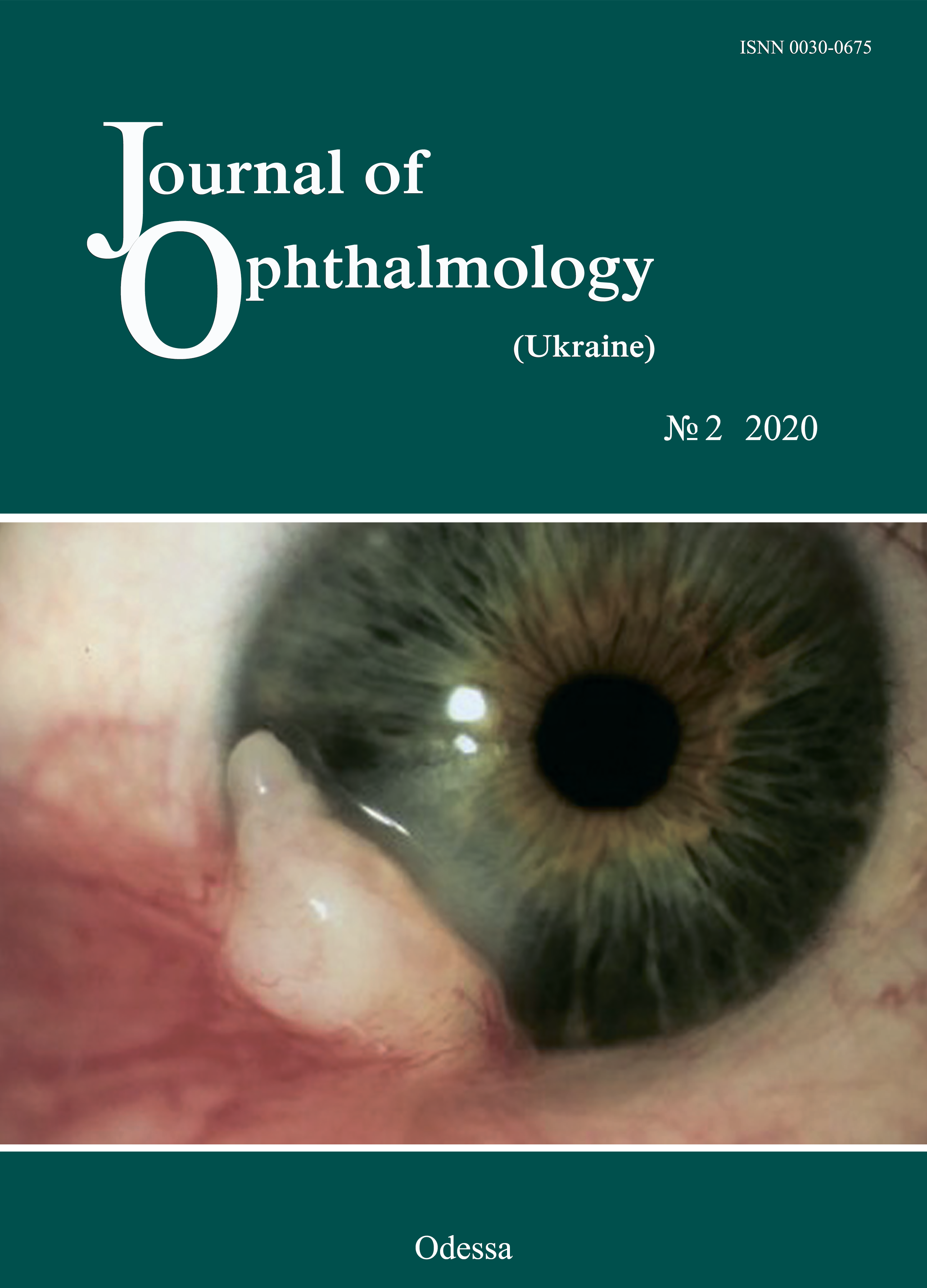System analysis of factors in the pathogenesis of drusen formation in AMD
DOI:
https://doi.org/10.31288/oftalmolzh202025055Keywords:
age-related macular degeneration, platelet receptors, retinal pigment epithelium, drusen formationAbstract
Background: Age-related macular degeneration (AMD) is a major cause of visual loss in elderly individuals. However, the involvement of cell receptors in the initiation of retinal disorder in AMD has not been duly reflected in the literature. The absence of system analysis of pathogenetic mechanisms of drusen formation restricts the possibilities for researchers to develop methods of treatment and prevention of early AMD.
Purpose: To carry out system analysis of novel factors in the pathogenesis of drusen formation in AMD.
Material and Methods: This prospective study included 109 patients (186 eyes) with intermediate stage of dry AMD. All patients received a detailed eye examination before and in the course of treatment. We used receptor ligands (specifically, adenosine triphosphate (ATP), adenosine diphosphate (ADP), adenosine, platelet activation factor (PAF), adrenaline and isadrine) to examine the functional activity of platelet receptors. Platelet aggregation was assessed by the turbidimetric method. The effect of platelet reactivity on the formation of drusen in the RPE was also assessed.
Results: The comparison of Group 1 patients with and without drusen (subgroups A and B, respectively) versus controls with regard to platelet reactivity indicated that hyperreactivity of alpha-2 adrenoreceptors reflected early accumulation of metabolite residues in RPE cells and appearance of drusen in the retina. An increase in drusen numbers in the RPE in Group 2 (subgroup C) patients with early dry AMD compared to subgroup B with was reflected by increased activity of P2X purine receptors (р < 0.05) and A2A adenosine receptors (р < 0.001). In group 3 (subgroup E) patients with intermediate stage of dry AMD, an increase in the size of drusen was accompanied by changes in activity of the four examined platelet receptors, with increases in sensitivity of alpha-2 adrenoreceptor, P2X and PAF receptors, and a decrease in sensitivity of beta-2 adrenoreceptor.
Conclusion: Platelet receptors reactivity reflected the effect of factors in the pathogenesis of AMD on drusen formation, and, therefore, can be used for prediction of the risk of disease progression.
References
1.Brandl C, Br?cklmayer C, G?nther F, Zimmermann ME, K?chenhoff H, Helbig H, Weber BHF, Heid IM, Stark KJ. Retinal Layer Thicknesses in Early Age-Related Macular Degeneration: Results From the German AugUR Study. Invest Ophthalmol Vis Sci. 2019; 60(5):1581-94. https://doi.org/10.1167/iovs.18-25332
2.Jonasson F, Fisher DE, Eiriksdottir G, Sigurdsson S, Klein R, Launer LJ, Harris T, Gudnason V, Cotch MF. Five-year incidence, progression, and risk factors for age-related macular degeneration: the age, gene/environment susceptibility study. Ophthalmology. 2014; 121:1766-72.https://doi.org/10.1016/j.ophtha.2014.03.013
3.Khan JC, Thurlby DA, Shahid H, Clayton DG, Yates JR, Bradley M, Moore AT, Bird AC. Smoking and age related macular degeneration: the number of pack years of cigarette smoking is a major determinant of risk for both geographic atrophy and choroidal neovascularisation. Br J Ophthalmol. 2006; 90:75-80.https://doi.org/10.1136/bjo.2005.073643
4.Algvere PV, Kvanta A, Seregard S. Drusen maculopathy: a risk factor for visual deterioration. Acta Ophthalmol. 2016;94(5):427-33.https://doi.org/10.1111/aos.13011
5.Hyttinen JMT, B?asiak J, Niittykoski M, Kinnunen K, Kauppinen A, Salminen A, Kaarniranta K. DNA damage response and autophagy in the degeneration of retinal pigment epithelial cells-Implications for age-related macular degeneration (AMD). Ageing Res Rev. 2017; 36:64-77.https://doi.org/10.1016/j.arr.2017.03.006
6.Qin S, De Vries GW. Alpha2 but not alpha1 AMP-activated protein kinase mediates oxidative stress-induced inhibition of retinal pigment epithelium cell phagocytosis of photoreceptor outer segments. J Biol Chem. 2008; 283(11):6744-751.https://doi.org/10.1074/jbc.M708848200
7.Mitchell CH. Release of ATP by a human retinal pigment epithelial cell line: potential for autocrine stimulation through subretinal space. J Physiol. 2001;534(Pt 1):193-202.https://doi.org/10.1111/j.1469-7793.2001.00193.x
8.Reigada D, Zhang X, Crespo A, Nguyen J, Liu J, Pendrak K, Stone RA, Laties AM, Mitchell C. Stimulation of an alpha1-adrenergic receptor downregulates ecto-5' nucleotidase activity on the apical membrane of RPE cells. Purinergic Signal. 2006;2(3):499-507.https://doi.org/10.1007/s11302-005-3980-7
9.Madeira MH, Rashid K, Ambr?sio AF, Santiago AR, Langmann T. Blockade of microglial adenosine A2A receptor impacts inflammatory mechanisms, reduces ARPE-19 cell dysfunction and prevents photoreceptor loss in vitro. Sci Rep. 2018;8(1):2272.https://doi.org/10.1038/s41598-018-20733-2
10.Guha S, Liu J, Baltazar G, Laties AM, Mitchell CH. Rescue of compromised lysosomes enhances degradation of photoreceptor outer segments and reduces lipofuscin-like autofluorescence in retinal pigmented epithelial cells. Adv Exp Med Biol. 2014;801:105-11.https://doi.org/10.1007/978-1-4614-3209-8_14
11.Sanderson J, Dartt DA, Trinkaus-Randall V, Pintor J, Civan MM, Delamere NA, Fletcher EL, Salt TE, Grosche A, Mitchell CH. Purines in the eye: recent evidence for the physiological and pathological role of purines in the RPE, retinal neurons, astrocytes, M?ller cells, lens, trabecular meshwork, cornea and lacrimal gland. Exp Eye Res. 2014;127:270-9.https://doi.org/10.1016/j.exer.2014.08.009
Downloads
Published
How to Cite
Issue
Section
License
Copyright (c) 2025 С. Ю. Могілевський, Х. В. Ковальчук

This work is licensed under a Creative Commons Attribution 4.0 International License.
This work is licensed under a Creative Commons Attribution 4.0 International (CC BY 4.0) that allows users to read, download, copy, distribute, print, search, or link to the full texts of the articles, or use them for any other lawful purpose, without asking prior permission from the publisher or the author as long as they cite the source.
COPYRIGHT NOTICE
Authors who publish in this journal agree to the following terms:
- Authors hold copyright immediately after publication of their works and retain publishing rights without any restrictions.
- The copyright commencement date complies the publication date of the issue, where the article is included in.
DEPOSIT POLICY
- Authors are permitted and encouraged to post their work online (e.g., in institutional repositories or on their website) during the editorial process, as it can lead to productive exchanges, as well as earlier and greater citation of published work.
- Authors are able to enter into separate, additional contractual arrangements for the non-exclusive distribution of the journal's published version of the work with an acknowledgement of its initial publication in this journal.
- Post-print (post-refereeing manuscript version) and publisher's PDF-version self-archiving is allowed.
- Archiving the pre-print (pre-refereeing manuscript version) not allowed.












